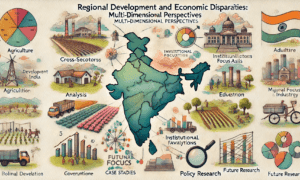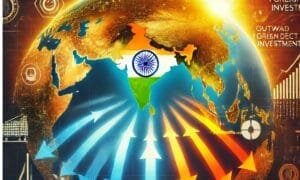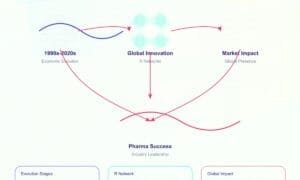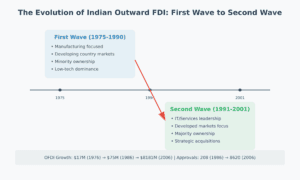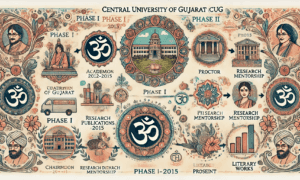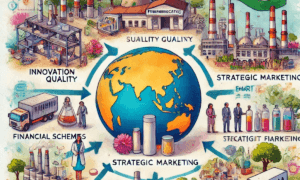Prologue: Delhi, 1955
Picture a 19-year-old student at Punjab University, deeply absorbed in economic textbooks. Outside his window, a newly independent India is taking its first steps toward industrialization. The young man, Ashok Mathur, is troubled by questions that would define his life’s work: Why are some regions of India prospering while others lag behind? How can education transform a nation’s workforce? What role should government play in steering development?
These questions would shape not just his career but influence how India understood its own development journey.
Act 1: The Foundation Builder (1955-2002)
The Journey Begins Like a detective piecing together a complex puzzle, Mathur’s academic journey took him from Punjab to Cambridge, and then to the London School of Economics. His quest wasn’t solving a crime – it was understanding how India could transform itself from a poor, colonial economy into a modern industrial nation.
Five Big Ideas That Changed Development Thinking
- The Growth Balance Instead of seeing balanced and unbalanced growth as competing strategies, Mathur showed they were complementary – like using both hands to climb a ladder. His 1966 paper in Oxford Economic Papers became a classic in development literature.
- The Regional Development Puzzle Breaking from tradition, Mathur pioneered detailed analysis of why different states grow at different rates – like understanding why different plants in the same garden grow at different speeds. His work in Economic Development and Cultural Change (1983) revolutionized how we think about regional disparities.
- The Education-Development Link Through his research, including groundbreaking work at JNU, Mathur demonstrated how investing in human capital creates ripple effects throughout the economy.
- The Industry-Agriculture Connection Rather than treating them as separate sectors, he showed how industry and agriculture are interconnected – like two wheels of the same bicycle. His 1990 paper in Development and Change remains influential today.
- The Employment Challenge He demonstrated how job creation needs to be understood at multiple levels – from village to metropolis – influencing both policy and academic thinking.
Act 2: The Legacy Continues (Contemporary Research)
“Today, a new generation of scholars builds on Mathur’s foundational work, exploring how his insights apply to contemporary India. Their research, presented in this volume, weaves together three interconnected stories.”
Story 1: The Tale of Two Indias – Regional Development Modern research reveals:
- Growing gaps between states since economic reforms
- The special challenges of North-eastern states
- Manufacturing’s role in regional inequality
- The informal sector’s productivity variations across regions
Story 2: The Changing World of Work Contemporary studies show:
- Rural-to-urban shift in small enterprises
- IT sector’s transformative impact
- Women’s changing role in informal economy
- New employment patterns in globalized India
Story 3: India in a Globalizing World Recent research examines:
- Impact of 1991 reforms
- Banking sector evolution
- Software industry success story
- Women’s status and economic growth
Act 3: Practical Implications for Modern India
Regional Development:
- Multi-level planning approach needed
- Infrastructure focus in lagging regions
- Targeted informal sector strategies
Employment and Skills:
- Support for rural enterprises
- Technical skill development
- Women workers’ needs
- IT sector competitiveness
Policy Framework:
- Balance global opportunities with local protection
- Banking sector modernization
- Innovation promotion
- Gender-sensitive development

Epilogue: The Questions Continue
The young student’s questions from 1955 still resonate today, but thanks to decades of research by Mathur and his academic descendants, we have better tools to answer them. Modern India faces new challenges:
- Balancing growth with equity
- Managing urbanization
- Competing globally
- Ensuring inclusive development
The research presented in this volume shows how Mathur’s foundational ideas can help address these contemporary challenges. His legacy lives on through:
- The institutions he helped build
- The students he mentored
- The ideas he developed
- The policy frameworks he influenced
Final Reflection: This collection of research reminds us that development economics isn’t just about numbers and models – it’s about understanding how to improve lives across a vast and diverse nation. The questions that fascinated young Mathur in 1955 continue to drive research and policy today. But now, thanks to his work and that of his academic descendants, we have richer, more nuanced ways to address them.
The journey from that young student’s questions to today’s sophisticated research represents not just one scholar’s career, but India’s own journey from a newly independent nation to an emerging global power. The research collected here points the way forward, suggesting how India can build on past progress while addressing new challenges in an increasingly complex world.
Academic Abstract:
This volume honors Professor Ashok Mathur’s contributions to development economics through a collection of empirical studies examining India’s industrialization, economic reforms, and regional development. The papers analyze three key themes: regional economic disparities, labor market transformations, and impacts of economic reforms and globalization. The regional development studies reveal widening interstate disparities post-1991 reforms, particularly pronounced in manufacturing and informal sectors. Labor market analyses demonstrate significant rural-urban shifts in employment, growing feminization of informal work, and emergence of the IT sector as a major employer. Papers examining economic reforms highlight both opportunities and vulnerabilities from global integration, while emphasizing the need for complementary domestic policies in banking, industrial development, and human capital formation. The volume makes important theoretical and empirical contributions to understanding India’s development challenges through rigorous sectoral and spatial analyses. It provides evidence-based policy insights for promoting balanced regional growth, productive employment generation, and globally competitive industrial development while ensuring social inclusion.
Learn More:
Full citation: S.K. Thorat, Jaya Prakash Pradhan and V. Abraham (2005) (eds.), Industrialization, Economic Reforms and Regional Development: Essays in honour of Professor Ashok Mathur , New Delhi: Shipra Publication.
Learn More:




